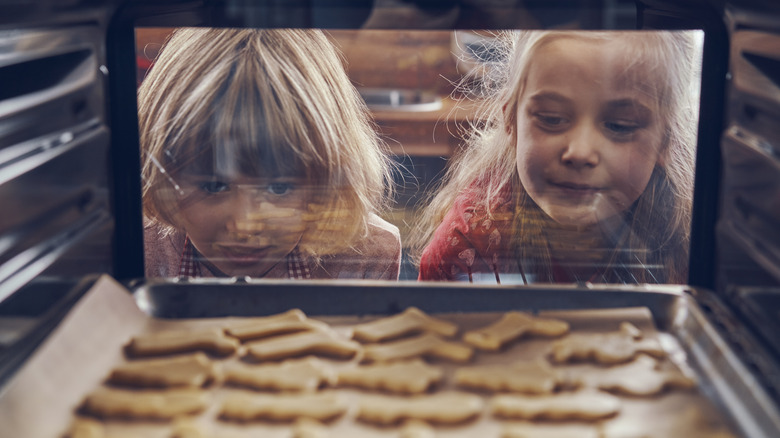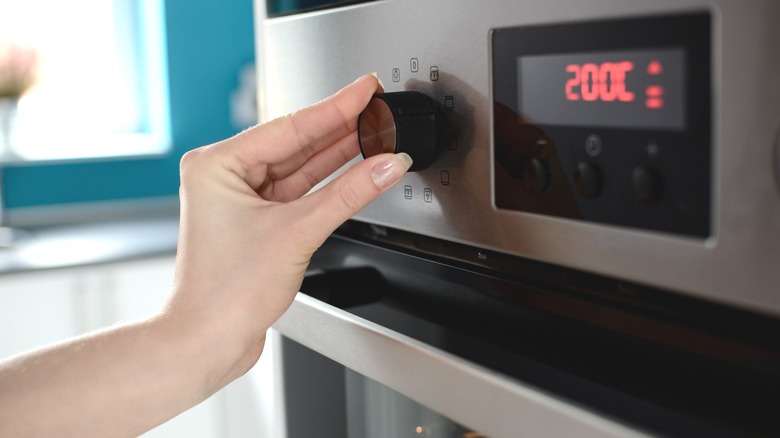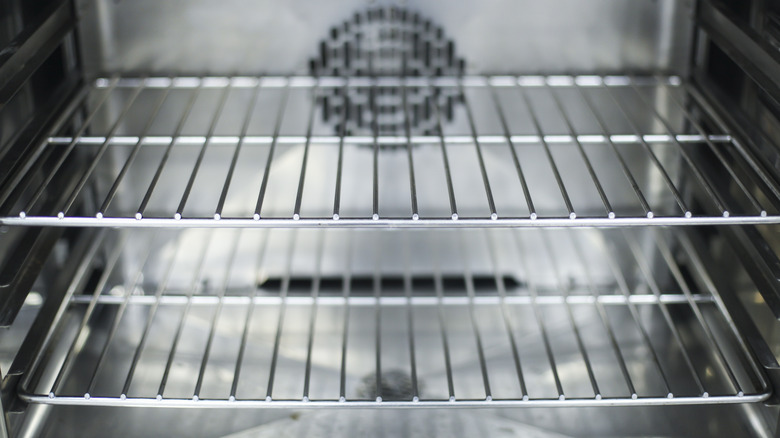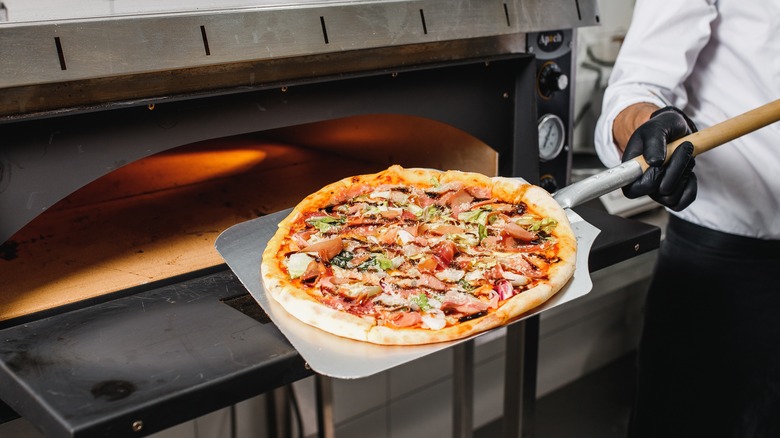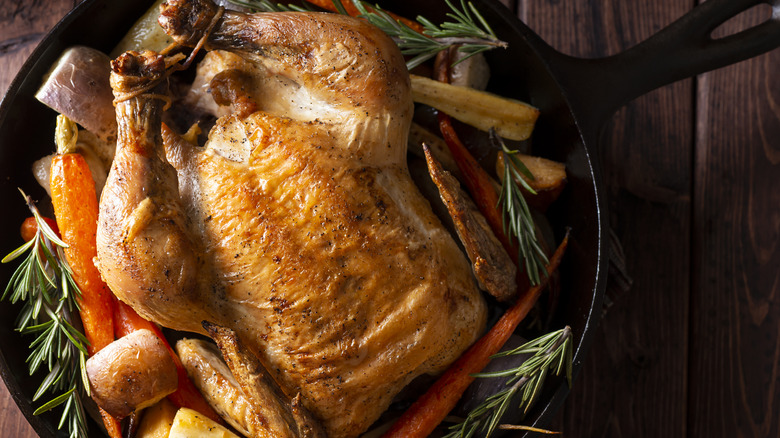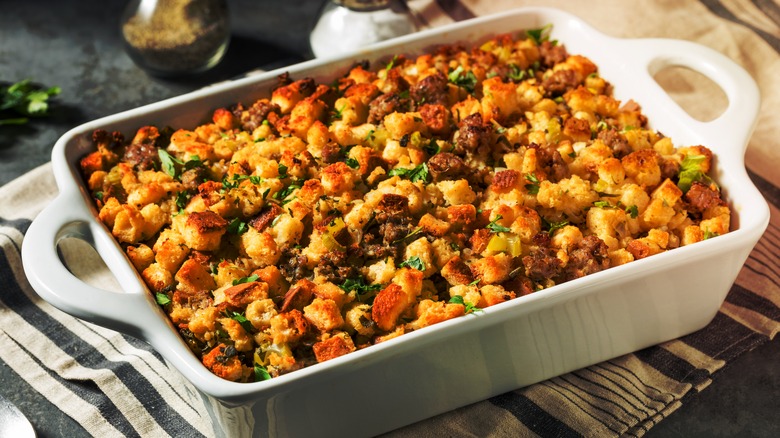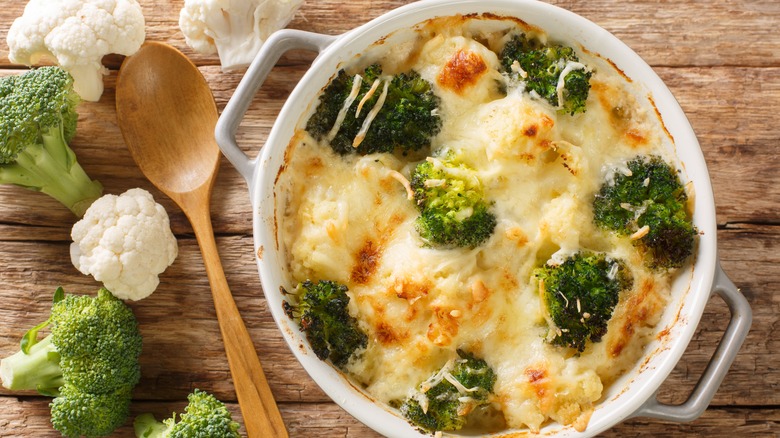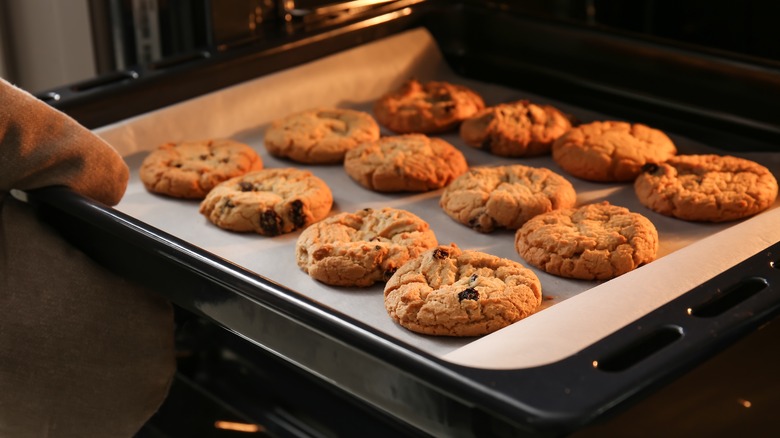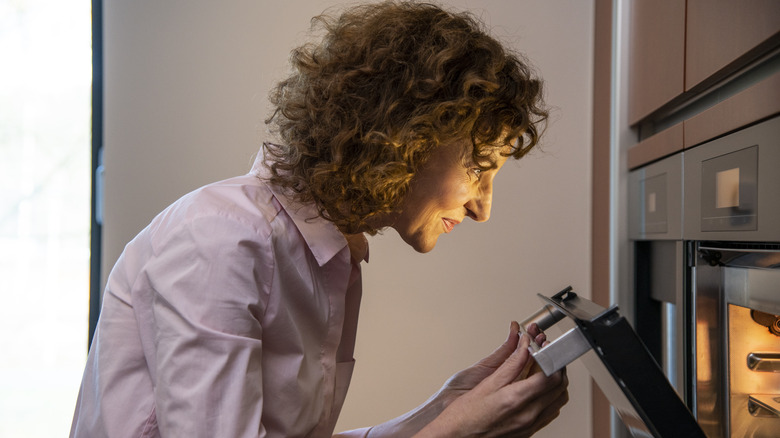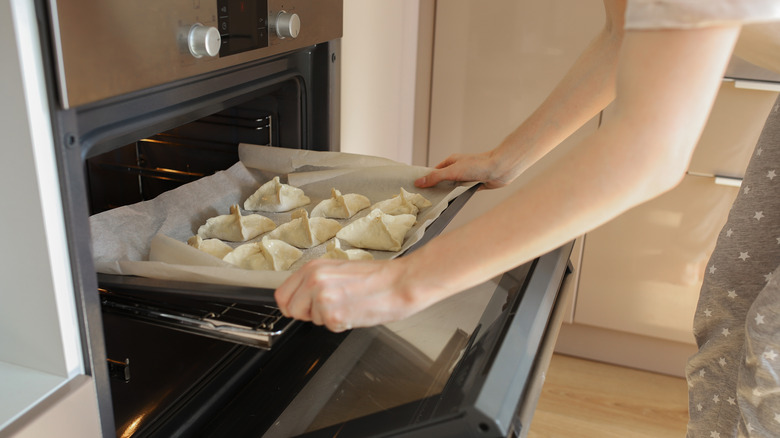Preheating Vs Cooking In A Cold Oven: Everything You Need To Know
Since they were just kids playing with their Easy Bake Oven, many bakers have been asking themselves (and the internet) the same question: Is it really necessary to preheat the oven? "I don't want to wait," they cry, "I want to cook!"
The difference between a preheated oven and a cold oven is not just time, however, it is science. As time-consuming as it may appear to be, preheating the oven actually helps to start chemical reactions that make things like bread and cakes rise and give that lovely, brown outer crust to your pot roast.
While certain foods might be fine to start cooking in a cold oven, this is not really the norm. If your recipe includes eggs, yeast, or any other type of leavening agent, or if you want a golden brown exterior with a well-cooked (read: not raw) interior, you will have to put aside your misgivings and get on the preheating bandwagon.
Everything in baking revolves around chemistry, and not factoring that into your recipes could result in some very hard, flat dishes you probably won't want to serve at your next family get-together. In the words of James Beard Award-winning cookbook author Dorie Greenspan, "When the recipe's instructions say preheat the oven — do it."
What does preheating mean?
If you are new to baking, you may not have thought about preheating the oven before. Luckily, it's an easy concept: Preheating, as the name implies, means heating up the oven to a certain temperature before putting in the cake, pizza, cookies, roast, etc. that you plan to cook. This is important because many baked goods need to start their cooking process at an elevated temperature. Pizza crust, for example, would not rise without an already-hot oven, and your grandma's delicious chocolate chip cookies wouldn't get the lightly crisp edges that make them so addictive.
Some impatient cooks would rather skip this step in the baking process because they only see it as a waste of time. Who has an extra 20 minutes to wait for the oven to get warm before cooking? But this is the wrong way to think about it. Preheating time doesn't have to be downtime. It could be the time you are actively putting your dish together or whipping up the batter; you'll have something to do while you're waiting and the food is ready to go in as soon as the oven is hot. See? No wasted time here!
What is a cold oven?
A cold oven is the opposite of a preheated oven, in that it is not hot when you start baking. Technically, the name is a bit of a misnomer, because unless you live at the North Pole without central heating, your oven will most likely be starting off at room temperature, not "cold" (so, in other words, we're not saying the oven is like a refrigerator here, we're just saying it's not hot yet).
Still, though, even starting with a room temperature oven is usually not the best idea for most dishes that need heat to make things crisp or rise. A cold oven may be okay, however, for dishes that don't need a big blast of heat at the beginning to get things started, such as when cooking bacon; it is better starting off with a cold oven so the fat melts from your bacon before it crisps.
If you don't have/don't want to use a microwave, you can also reheat meals in the oven. Starting with a cold oven in this case wouldn't change much because the food is already cooked and doesn't need that extra bit of chemistry that a preheated oven brings to the table.
Preheating starts a chemical reaction
We all know that heat is an important part of the cooking process (in fact, it could be argued that it's the most important, since without heat, we'd all be eating raw cake batter at our next birthday party). But what is lesser known is just why — and when — that heat is important.
Let's start with the basics: Baking is a series of chemical reactions that transform a list of ingredients into one unified, fluffy thing (in the case of bread and muffins) with a completely different appearance and taste. Yeast and baking powder, for instance, start reacting as soon as they are worked into dough or batter, and again when it is in the oven. The latter reacts with water/moisture to release carbon dioxide in the dough, which is the first step to fluffiness. It then reacts again when it reaches the required temperature in the oven, creating bubbles of gas that make the cake rise.
Yeast, too, creates bubbles of carbon dioxide that help dough grow. If that yeast doesn't come into contact with a high enough heat level at the start of the cooking process, those bubbles won't form and the bread or pizza crust you are making will remain flat and hard.
What kinds of baked goods call for a preheated oven?
Let's be honest: To be on the safe side, you may want to just assume that the majority of baked goods need a preheated oven. There may be some exceptions, but these are few and far between.
Any recipe that includes a leavening agent needs to start the cooking process in a hot oven, as do recipes with eggs. Without an initial wave of hot air to get things going, your pizza, bread, cookies, or cake may eventually get cooked, but it will most likely be like a rock on the inside, pale and hard on the outside, and/or mushy in places. In other words, they won't rise and they won't cook evenly, so what you end up with will be a far cry from the picture in your cookbook.
A general list of foods that require a preheated oven includes cake, pie, pizza, bread, brownies, souffle, biscuits, muffins, meringues... Basically, if it needs to rise, you need to preheat the oven.
Do meat and vegetable dishes require a preheated oven?
Any meat dishes that require a nice, brown crust on the outside and a moist, juicy interior like roasted chicken or pot roast need to start in a preheated oven. Contrary to popular belief, this browning on the outside starts in the first few minutes of cooking –- it does not come from cooking the chicken or roast for a long time. In fact, just like when cooking a steak on the stove or grill, cooking it slowly over a long period of time with low heat won't lead to a nice crust, it will just lead to dry, chewy meat; or worse, it could lead to meat that tastes like it has been boiled (which, for meat, is almost always a bad thing).
Just as with meats, roasted vegetables are at their best when they are crisp on the outside but moist on the inside. To get that nice, caramelized color, you need to hit the veggies with a blast of heat right from the start. Otherwise, you'll most likely end up with a mushy dish, or one with undercooked potatoes in some places and unintentional carrot puree in others.
When is it okay to start with a cold oven?
Okay, so maybe every rule really is made to be broken. Even though it is highly recommended to preheat the oven most of the time, there are some dishes that turn out just fine if they warm up as the oven does. Dishes like casseroles, braises and baked pastas, for instance, are meant to be cooked slowly and don't need to rise. While they may get a crust on top from browning cheese or something similar, this type of dish typically doesn't need to be crispy to be good. For this reason, a cold oven is no issue.
You can also heat up pre-cooked dishes in the oven. For example, if you made a pizza yesterday with a nice, airy, lightly browned crust, you could reheat it in an oven that starts off at room temperature. This is because the chemical processes needed to achieve your perfect pizza goals have already occurred, so you don't need to repeat them.
There is also a school of thought that posits that baking certain types of drop cookies in a cold oven leads to better, more consistent spreading of the dough. King Arthur Baking also recommends taking a chance with starting quick breads in a cold oven, as the lower temperature at the start can help them to rise more slowly — but to higher heights — than a preheated oven.
How a cold oven affects cooking time
While it is sometimes totally fine to start a dish in a cold oven, there are some things to keep in mind. The most important of these is that not preheating the oven probably won't save you all that extra time you were hoping for.
Putting a dish into the oven when it is cold means that it will take longer for that dish to get heated all the way through, especially if it has a lot of moisture, like lasagna or baked macaroni and cheese. In most cases, you will have to add on around 20 minutes of extra cooking time... which is probably around the same amount of time you would have spent preheating the oven.
Keep an eye on your dishes in this case, however. Sometimes adding this extra cooking time can cause them to be undercooked in the middle but dry on the outside. Don't just leave your dinner to its own devices without checking back in every now and then.
Oven temperature recommendations
The ideal oven temperature depends on what dish you are baking. Pizzas, for example, require a massive blast of heat right out of the gate, so your oven should be set to somewhere between 400 and 500 degrees F. Anything less makes for a pizza with a crust like a flat brick –- no one's idea of a good pie.
Cake recipes usually recommend 325 to 350 degrees F. This should be the temperature of the oven when the cake goes in, otherwise it may not rise and get fluffy. Cookies, too, are usually baked at 350 degrees F to ensure that they get that light crust around the edges, the puffy, moist center, and the golden brown exterior that makes them great. Some dishes like bread or roasted chicken may also require a higher temperature to start (think 400 to 425 degrees F), then the temperature is lowered to a more moderate one to complete the cooking process.
In any case, unless you are inventing a new flavor of cake with no guidelines to consult, it is usually best to just go with the temperature written in the recipe. It was written for a reason.
How long does it take an oven to reach the right temperature? (And how can you know when it has?)
Usually, it takes around 15 to 20 minutes for an oven to reach the set temperature, but this can vary based on the target temperature, the size of the oven, and the oven itself. For example, if you are heating the oven to 500 degrees F, it will most likely take longer, sometimes up to 30 minutes. If your oven is small, it may only take 10 minutes. Another thing to consider is how finicky your particular oven is. If you know it is temperamental and likes to take its time getting ready, then you should factor in a bit more preheating time.
Luckily, in most cases, the oven will let you know when it has reached the right temperature. Newer ovens will usually make a sound, like a ding or a buzz. Other, older ovens may have a light instead, which stays on until the oven reaches the right temperature, then goes off.
If your oven has neither of these features, don't despair. In this case, an oven thermometer is a good investment. It can be left in the oven so you can keep an eye on the temperature. This also comes in handy when cooking more delicate dishes that need to be kept at a stable, constant temperature.
Is preheating the oven a waste of energy?
While some people might feel like preheating the oven is a waste of time, others feel like it's a waste of energy. And they could be right in certain instances. Preparing your food while preheating the oven is a great way to increase your time efficiency, but if your prep time ends up taking an hour when the oven is ready after 20 minutes, then you lower your energy efficiency.
While preheating is often a necessity, it is recommended that you (and your dish) are ready when it is. Consider this when planning and prepping. If you know that you are a bit slower with the walnut chopping or carrot peeling, do those things before turning on the oven. When you know you're around 15 to 20 minutes from being ready to put your food in, that's when you should start the preheating process. That way, you and the oven are ready at the same time, and no energy — or time — is wasted.
